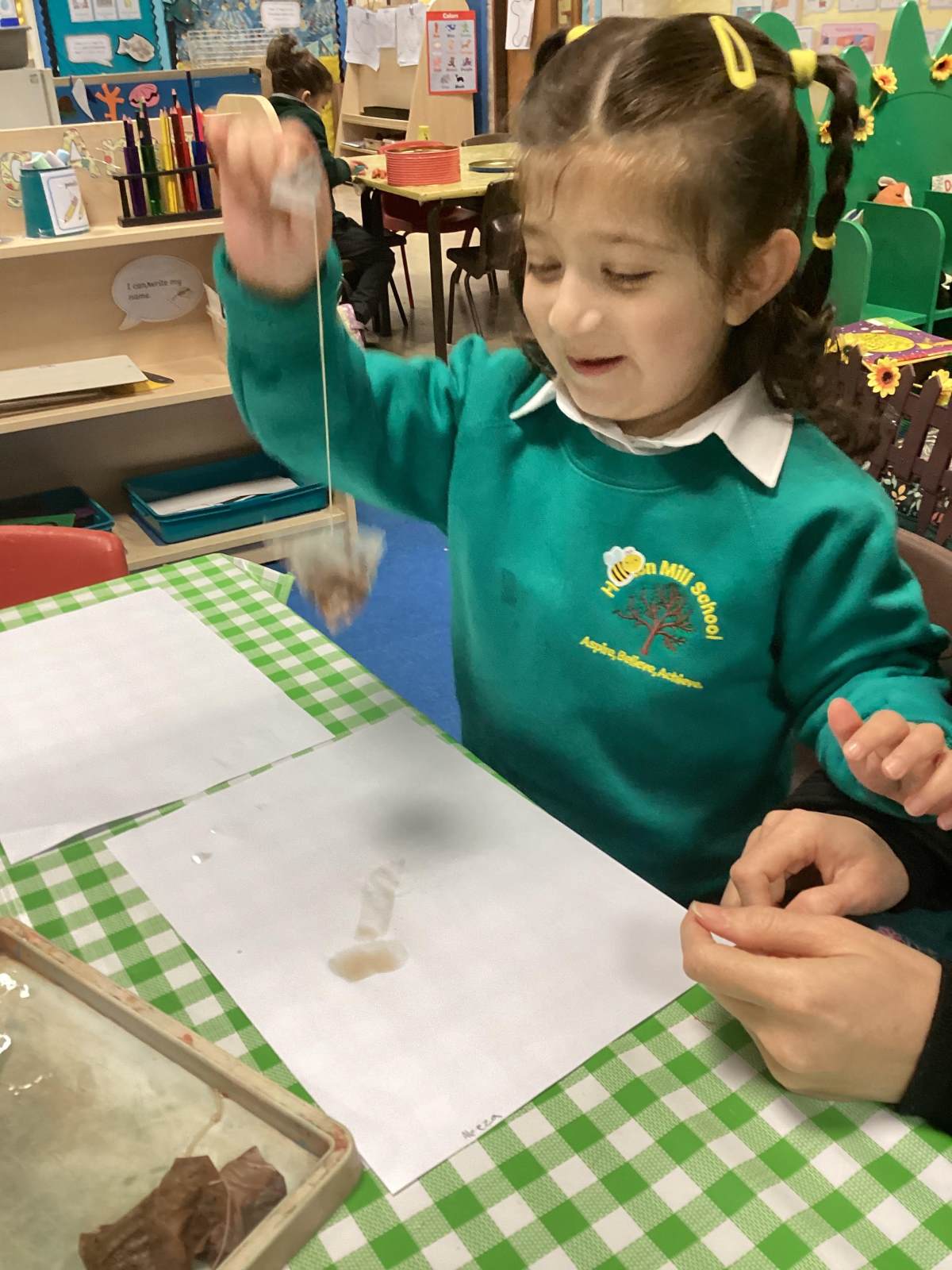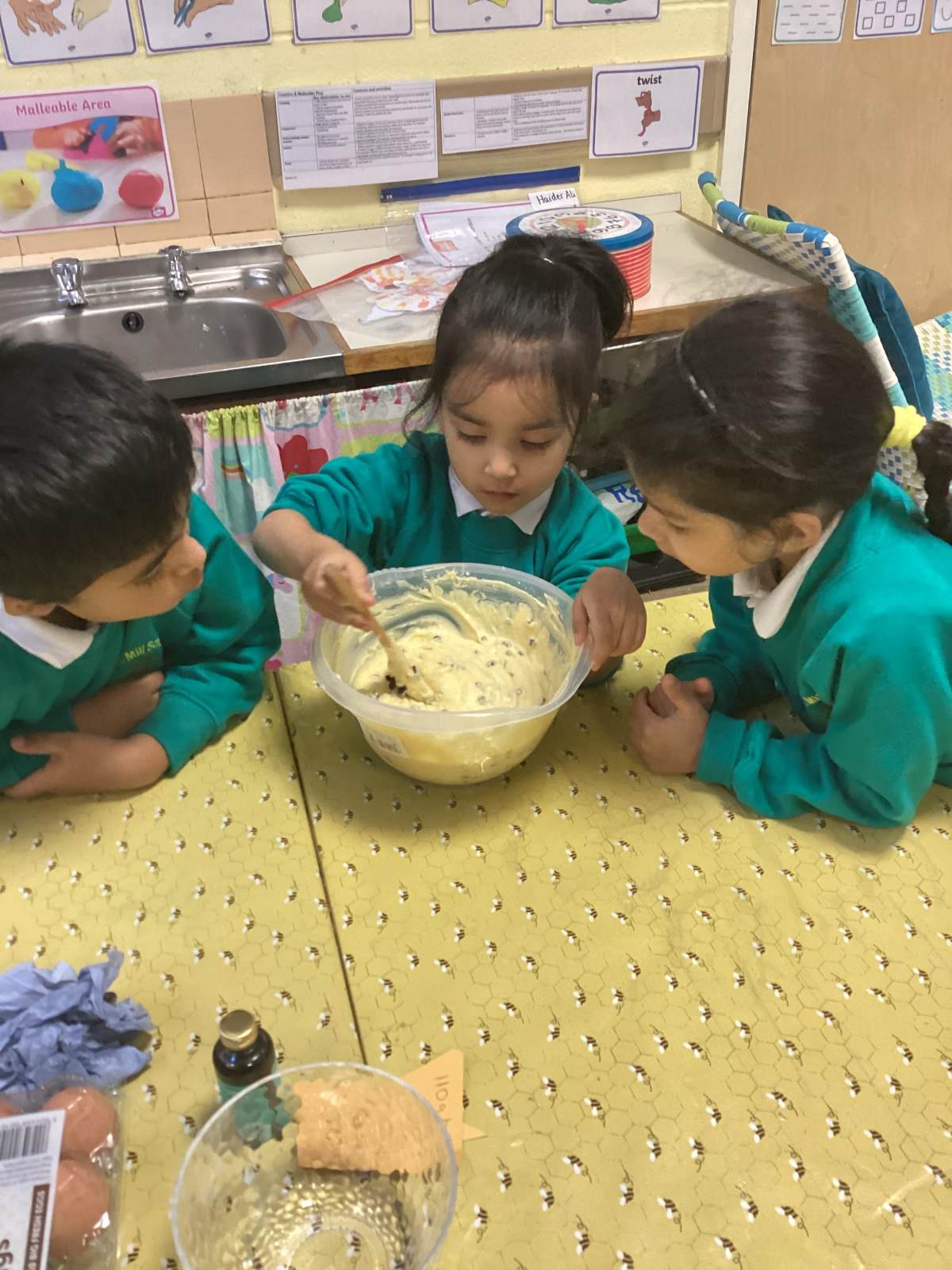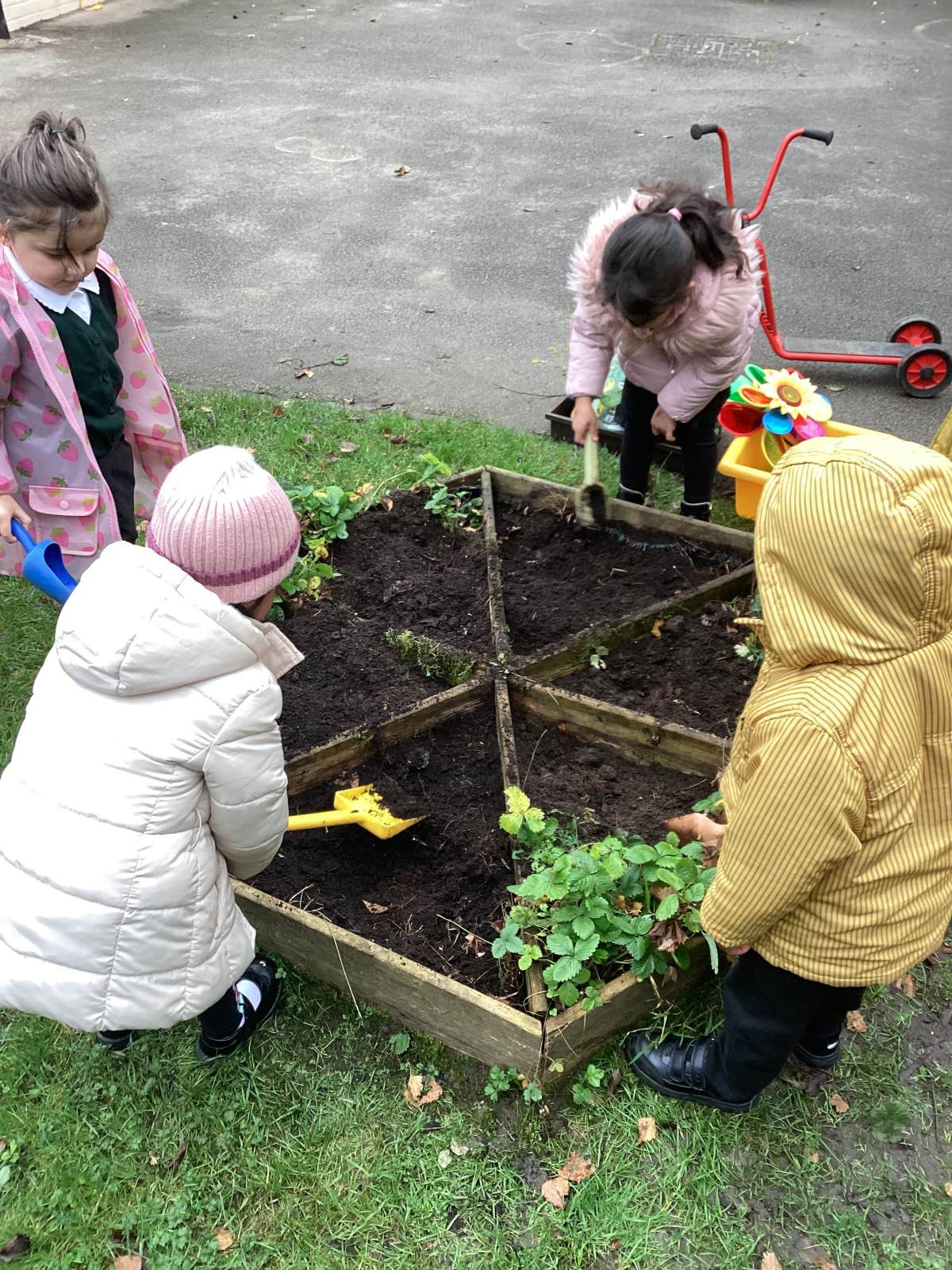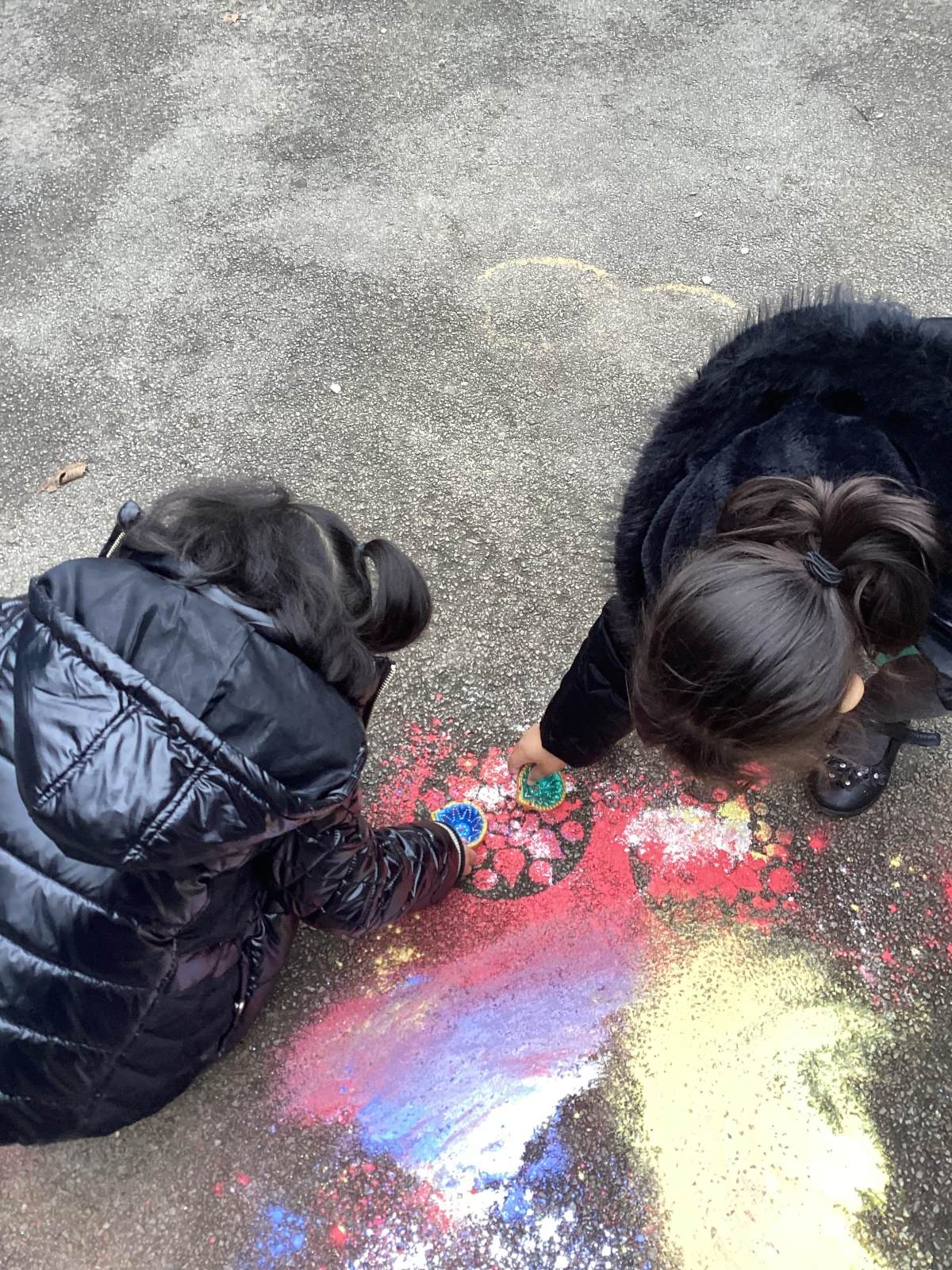NurserY
Hello parents and children,
A big Welcome to our Nursery Web page.
Click the link below to watch a video of the inside of our Nursery. Talk about what you can see.


We firmly believe in close family involvement. You are the most important people in your child’s life and your role is greatly valued.
We have tried to answer regularly asked questions. We hope you find this information helpful.
Please come to speak to us in Nursery if you have any questions or concerns.
Who will be supporting my child in Nursery?
Mrs Bush - Class Teacher
Mrs Begum - HLTA
Mrs Parveen -TA
Mrs Nadim - TA
What time are the Nursery sessions?
Morning session - 8.30 am until 11.30 am
Afternoon session – 12.15 pm until 3.15 pm
Parents are eligible for either a part-time place (15 hours per week – 3 hours per day in the morning or afternoon) or a full-time place (6 hours per day - the extra half hour over the lunchtime period is provided free of charge).
If parents are not eligible for a full-time place, they can choose to pay for the additional 15 hours at a cost of £75 per week.
School dinners are available at a cost of £2.90 per day or parents can send a packed lunch from home instead.
Other charges, such as for school trips (prices depend on the individual trip), are voluntary.
In the interest of child safety we ask that a known adult brings and collects your child at the beginning and at the end of each session. Please let the school office know beforehand if this changes. As a safety precaution, the Nursery gate is locked at all times throughout the day.
What will my child Learn?



We ensure that the curriculum we offer meets the needs of the developing child. We use the Early Years Outcomes as a guide to inform the curriculum. This focuses on helping them to develop the skills in the three prime areas and four specific areas of learning both indoors and outdoors.
Prime Areas
Personal, Social and Emotional Development
Physical Development
Communication and Language
Specific Areas
Literacy
Mathematics
Understanding the World
Expressive Arts and Design
Does my child have to wear a uniform everyday?
The children do wear a school uniform. All children wear a white polo shirt, school jumper and black or grey jogging pants.
When the children are ready they wear pumps for PE in the hall.
Please make sure you write your child’s name on all items of clothing they wear to school.
Please ensure your child comes to school with a warm coat and sensible shoes.
In cold weather, please send your child with a hat and gloves.
In hot weather, please send them with a hat, a cap or protection for the head.
In wet weather, we will still go outside but the children will wear waterproofs. Please send a pair of wellies to be kept in school for your child to wear.
For safety purposes, please ensure your child is not wearing any jewellery.
On their birthday they can come to school in their own clothes, but due to allergies please do not bring in any food treats such as cake or sweets.
Where do I drop off and pick up my child?
Your child will need to be picked up and dropped off at the Nursery door by one parent. Please follow the markings painted on the ground.
Will my child be given snacks and drinks during the school day?
Our Nursery is taking part in the fruit and vegetable scheme, which means that your child will be given a piece of fruit or vegetable each session. They will be given milk in a cup each day.
Please send a bottle of water with your child’s name on each day. They will be able to drink the water when they are thirsty.
Please do not send juice or fizzy pop.
How will they be taught?
Your child will complete daily tasks, such as phase 1 phonics, maths sessions and other adult led inputs.
We also use a challenge curriculum where we ask questions and then do activities to help answer them.
Each week your child will bring home a Newsletter which will tell you what we are doing in Nursery and give ideas of activities that you can do with your child at home. These ideas can also be found on our Learning Journey display by the Nursery entrance. This way you can see what your child has been up to during the week.
They will have access to activities both inside and outdoors.
They will also take part in child chosen activities.
Where possible we try to give them first hand experiences.
They will also take part in lots of exciting projects.
The children will be taught by a music specialist on Monday morning and Friday afternoon. They will be take part in a wide range of listening, singing and instrumental activities.
We will have a PE session in the hall on Monday afternoon and Tuesday morning.
I am worried my child may get upset.
Children vary greatly in their response to Nursery. Both you and your child may feel anxious for a while. This is quite common and natural and we are always on hand to support you and your child.
How can I be involved?
We see parent involvement as essential. You are invited into Nursery at the beginning of each session to complete a short activity. This will take 5 -10 minutes.
We will run a parent event every half term which we will invite you to.
There will be a parents meeting in Autumn and Spring and you will receive a report of your child’s progress in Summer.
How can I help my child to be ready for school?
Starting Nursery can feel a very big change for your child. Helping them feel ready will help them to settle more quickly. Talking about starting Nursery in a positive way, attending transition meetings and visits and helping your child become more independent will all help to make this transition easier. Please see the link below for more information about how we will help your child settle into Nursery.
Ways to help your child to learn and develop at home.
Our Learning Journey is updated weekly, with new ideas to try at home as well as the Noticeboard outside the Nursery doors. It will explain what your child has been learning in Nursery.
There are lots of ideas of activities you can do with your child at home on:https://www.bbc.co.uk/tiny-happy-people
Other ways to help your child at home:
1. Make time for your child’s passion every day
Talk about their interests, help them develop new skills and support them in reaching their ambitions.
2. Exercise!
Our brains need oxygen flowing through them so whether it’s kicking a ball, learning a dance video, jumping on the trampoline or creating an obstacle course in the garden.
3. Eat together and talk
At the kitchen table, talk about what you’ve been doing during the day. Ask them to share the things that they’ve learnt. You might be surprised by your child’s opinions on the big things, however small they are.
4. Read
Read together, create cosy reading dens and get them to keep a record of all the reading they’ve done to impress their teacher when they return. This can be a great way to inspire reading for pleasure.
5. Play games
Tackle jigsaws, build Lego – great for problem solving and developing creativity.
How to help your child develop their Listening Skills
- Make sounds with objects around your home. Give your child a signal to GO or when to STOP. After a few times, let your child be the leader so they can tell you when to start or stop.
- Give instructions for your child to do an action but they must wait until you say GO
- e.g. Clap your hands……………GO!
- Say a familiar Nursery rhyme or read a favourite story and make mistakes – can your child spot the mistakes?
- Use 3 or 4 different sounds on a phone or iPad. Tell your child to do a particular action for each sound e.g. bell – roll arms, swoosh – stretch up tall, boing – jump up and down.
- Play hide & seek: Hide some toys around your home and ask your child to go and find them. Make a sound when they are getting closer and a different sound when they are getting further away.
To help develop your child’s understanding of language
- Find objects around the home following certain categories e.g. something you can drink from, something you can sit on, something you can wear, something you can cut with. Something shiny/soft/bumpy/noisy
- Take photos of you doing an activity with your child e.g. baking, washing up, sorting clothes, putting your shopping away, craft activities, physical exercises. Look back at the photos and talk about what you did in order.
- Play hide and seek with a favourite toy – make the toy hide in/on/under/behind things. Use the position words to say where you have found the toy e.g. ‘She’s under the TV’
- Play shopping/café games. Ask your child to give you 2 or 3 items. Can they remember what you have asked them for?
- Talk about your daily routine – what did you do in the morning/afternoon/at bedtime
Word Challenge!
How many new words can your child learn each day?
Sing some Nursery rhymes together.
Press the links below and join in singing.
https://www.bbc.co.uk/teach/school-radio/nursery-rhymes-songs-medleys/zf2792p
https://www.youtube.com/watch?v=YAJynCIsNUg
http://www.bbc.co.uk/cbeebies/tweenies/songtime/songs/viewall_songs.shtml
Share stories together
Share a story together using a book, oxford owls, storyplace or watch the video link below of Mrs Bush reading the story Hippo Has a Hat by Nick Sharratt.
Hippo Has a Hat by Julia Donaldson and Nick Sharratt
Username: horton mill nursery password: green
Watch the phonics fairy read the stories by pressing the links below.
https://www.youtube.com/playlist?list=PLV5E_EC-wNdjn1acTqEmsthWLY55q6tCs
Maths Ideas
- Go on a ‘Number hunt’ around your home.
- Count objects https://www.twinkl.co.uk/resource/t-n-1238-counting-scenes-powerpoint-1-10
- Sing some number songs together. https://www.bbc.co.uk/teach/school-radio/nursery-rhymes-counting-medley/zj94y9q
- Go on a ‘Shape hunt’, finding different shapes around your home.
- Watch the singing walrus find shapes in the video link below.
https://www.youtube.com/watch?v=OEbRDtCAFdU
- Find some socks or house hold objects, mix them up and order them by length.
- Write a number on the top of a piece of paper and find some objects to match the numeral.
- Write numbers on pieces of paper or post-it notes and hide them around the house. When you find the number can you do that many actions e.g. 5 claps, 3 hops, 7 jumps etc.
- Find 1 cup, 2 combs, 3 spoons etc. Make some shapes out of the items you find.
- Practice forming the numbers correctly with pens or paint. Use the number formation cards to help you form them correctly.
/docs/imported/Nursery/Number20Formation20Rhyme20Cards.pdf
- Have fun setting up a role play shop. Write out price tags and enjoy buying and selling your items.
- Don’t forget counting is everywhere, count as you put toys on the table, walk up the stairs or even count how many family members are in a room.
- Make some play dough.
- Then join the play dough disco! https://www.youtube.com/watch?v=zJQ2CaA7E50&t=55s
- Make nursery rhyme puppets using wooden spoons and sing the songs together.
- Make some musical instruments out of house hold objects e.g. sound shaker with a plastic bottle and some beans, rice or stones. Can you keep a steady beat to your favourite song? the beat?
- Do some painting and watch how the colours mix.
- Use some Lego or building bricks and get building! Make something different each day e.g. a pirate ship, a rocket, a fairy castle, a zoo.
- If you have a ‘pretend kitchen’ in your house make some party food for your dolls or teddies.
- Make a picture with cut up bits of old clothes and talk about the different textures.
- If you have dressing up clothes, dress up and make up some stories. You could make a magic wand or treasure map to make your story even more exciting! Make a video of your story.
- Make a den using bedsheets and enjoy a story inside using your phone torches.
- Taste some new fruit & veg and talk about the importance of keeping healthy. Make a picture with cut up pieces of fruit or veg then enjoy eating it!
Your child will go through different stages of mark making.
These are all important in your child’s development.
At first they will make uncontrolled marks.
Over time these marks will become more controlled.
They will begin to distinguish between the different marks.
Between 30 to 50 months they will start to give meanings between the marks they draw and paint. “That is a bear.”
